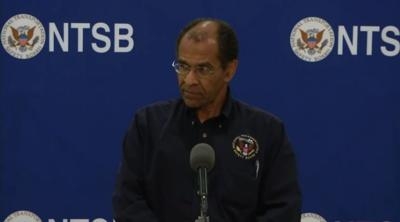Analysis Of Data Will Likely Take 12 Months Or More
Acting NTSB Chair Christopher Hart gave his final daily media briefing on the accident involving SpaceShipTwo Monday night.

In an NTSB video posted to YouTube, Hart (pictured) said that the telemetry from the spacecraft showed the following sequence of events (All times PDT):
- 10:07:19 Release from WhiteKnightTwo
- :21 Engine Start.
- :29 Vehicle reached .94 Mach.
- :31 Vehicle reached 1.02 Mach. At this point, the on-board video shows the person in the right seat unlocking the feathering mechanism. "Soon after that, the feather began to deploy," Hart said.
- :34 Video and telemetry were lost.
Hart said that it was the pilot in the right seat that unlocked the feathering mechanism. He said that the flight card for the aircraft indicates that the feather is not to be unlocked until the vehicle reaches 1.4 Mach. The feather is a two step process involving unlocking the mechanism and then engaging the feather to slow the spacecraft down for return to Earth. It is reported that co-pilot Michael Alsbury, who was fatally injured in the accident, was in the right seat and unlocked the feather.
Hart said that because this was a test flight, there are multiple data sources to be analyzed, and that will give the board a lot of material for its investigation. However, he said, the Board has not yet had an opportunity to interview surviving pilot Peter Siebold. Hart said that the NTSB is consulting with Siebold's medical team to determine when that interview might be allowed.
Hart said that a new Human Performances Group had been formed to look the human-system interface between the pilots and the spacecraft. The panel will look at issues such as displays, checklist design, and similar aspects of the system. "We anticipate the typical time frame for an accident like this. It may be helped by the rich data sources that we have, we may be able to move a little more rapidly but we would anticipate taking as much as 12 months to complete the analysis which would end up with a probable cause determination as well as recommendations."
Hart said that the cleanup of the accident site is continuing, and that small, lightweight pieces of SS2 are being found as much as 30 miles northeast of the main wreckage. He said it is not known if those parts were carried that distance aloft or if they blew along the ground. The largest piece of wreckage will have to be cut into smaller pieces for transport, Hart said.
In a statement, Virgin Galactic said that based on information they have released about their investigation to date, the NTSB has recovered the intact engine and rocket propulsion fuel tanks with no signs of burn through or mid-air explosion. This definitively dismisses the premature and inaccurate speculation that the problem was related to the engine or the fuel.
The NTSB also evaluated the vehicle’s feathering mechanism, which is the unique technology that turns the wing booms into position for re-entry. The NTSB indicated that the lock/unlock lever was pulled prematurely based on recorded speed at the time, and they have suggested that subsequent aerodynamic forces then deployed the feathering mechanism, which resulted in the in-flight separation of the wings and vehicle. "At this time, the NTSB investigation is still ongoing and no cause has yet been determined – these are purely facts based on initial findings," the company said. "We are all determined to understand the cause of the accident and to learn all we can."
 Unfortunate... ANN/SportPlane Resource Guide Adds To Cautionary Advisories
Unfortunate... ANN/SportPlane Resource Guide Adds To Cautionary Advisories ANN FAQ: Turn On Post Notifications
ANN FAQ: Turn On Post Notifications ANN's Daily Aero-Term (04.29.24): Visual Approach Slope Indicator (VASI)
ANN's Daily Aero-Term (04.29.24): Visual Approach Slope Indicator (VASI) ANN's Daily Aero-Term (04.28.24): Airport Marking Aids
ANN's Daily Aero-Term (04.28.24): Airport Marking Aids ANN's Daily Aero-Linx (04.28.24)
ANN's Daily Aero-Linx (04.28.24)



